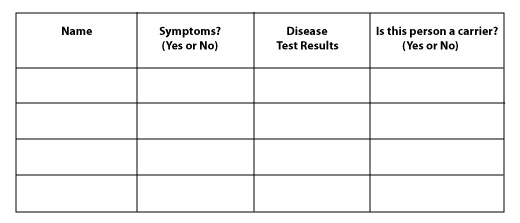SEPUP Scientific Thinking
“Who Infected Whom?”
Presented by John Howarth
Associate Director, SEPUP
Science Education for Public Understanding Program
Lawrence Hall of Science, University of California at Berkeley
john_howarth@berkeley.edu
Epidemiologists are scientists who trace the spread of a disease through a population. They do this to learn how the disease spreads and to find ways to help prevent its further spread.
One way epidemiologists gather such information is by going to a community and comparing sick people with healthy people. Their work is complicated because not all people who are exposed to an infection get sick. Vaccinations, previous exposure to an infection, and overall health affect whether a person who is exposed to an infection will become sick.
Sometimes there is no obvious connection among sick individuals. Epidemiologists then have to resort to testing for the infection in healthy people to find the transmission path. This is because you can pass on an infection before you know you are sick. Some infectious diseases (such as typhoid and diphtheria) can be carried (and spread) for a long time by someone who never develops symptoms of the illness.
These carriers can be important links in the spread of a disease.
Scenario
As you have just seen in the news clip, many students have become sick at Channing University. The first person identified with the disease was Dr. Smith, a professor at the University. Dr. Smith suffered from a high fever, sore throat, and a cough. At first no-one else became sick, but after 10 days many more people were diagnosed with similar symptoms. A local epidemiologist, Dr. Jose Silva, is working to identify the path of transmission: who infected whom? Dr. Silva suspects that a carrier is spreading the disease. In order to determine how the disease is spreading, he has begun to gather information. To date, he has interviewed eight individuals.
Challenge
Identify who is (or are) the carrier(s) of the disease.
You will work with your partner to use the information on the Interview Cards to develop a supportable hypothesis for the path of transmission of the disease.
Procedure
Part A: Evidence from Interviews
1. Read the information on the Interview Cards.
2. Discuss with your partner how the disease may have spread from person to person.
3. Move the cards around to develop a disease web showing who could have caught the disease from whom.
4. Create a diagram that shows your completed disease web. Be sure to include how you think these people are connected. For example:
Dr. Smith TRAV 61 Heather
(symptoms on June 3) (symptoms on June 7)
5. With your partner develop a hypothesis as to which person may be the carrier(s) of the disease. Make sure that your choice of person (or people) is consistent with your disease web.
6. In order to test your hypothesis, you will be able to test samples of “saliva” from this person
(or people) for the presence of the disease. Use the table in Part B to record the results of your test(s).
Part B: Collecting Lab Evidence
REMINDER: Good laboratory procedure means no accidental contamination! When using a dropper bottle, unscrew the lid but do not put the lid down on the table. Instead, use the bottle and immediately re-cap it.
7. Find the dropper bottle for the person (or people) you would like to test. It contains the “saliva” for that person (or people). Place 3 drops of the “saliva” sample into one of the small cups in your SEPUP tray.
8. Test the sample by adding 2 drops of Disease Indicator. Make sure the dropper does not touch the “saliva.” A positive test for the disease will show a pink color.
9. Record your results in the table shown below Procedure Step 10.
10. Repeat steps 7-9 for any other people you are testing.
Record test results in this table. Note: if the solution turns pink, this is a positive result for the disease in the saliva. If the solution remains clear, there is no disease in the saliva.
Discussion Questions
1. A group representing some of the students and staff of Channing University have demanded that the family members and close friends of all infected individuals stay home until everyone with symptoms gets better. Explain whether you agree with their demand. Support your answer with evidence and identify the trade-offs of your decision.
2. Would your change your answer to Question 1 if the disease had more severe symptoms and a greater chance of causing death? Explain.
3. In the current outbreak of H1N1 influenza many countries have adopted steps that they hope will reduce the spread of the virus.
- Discuss with your partner the following examples of procedures used at various airports around the world. Be ready to share your discussion with the group.
- Monitoring all persons entering the country by using cameras that indicate body temperature and quarantining those people with high temperatures.
- Quarantining (1 week) all persons with Mexican passports.
- Filling out forms that indicate whether you have been in an infected area along with your contact information.
- Canceling flights to and from certain countries.
4. Listen to the story of Typhoid Mary and then watch the video clip at:
http://www.sepuplhs.org/movies/odys08_vid_bubonic_350.mov
Be prepared to discuss the following question:
How do you balance the needs of society with the rights of the individual?

 Canvas
Canvas
 Donate
Donate
 Let's Talk!
Let's Talk!



Comment section
1 thought on “SEPUP Who Infected Whom?”
Comments are closed.